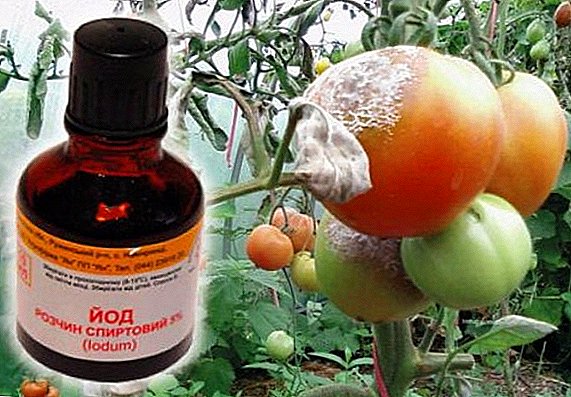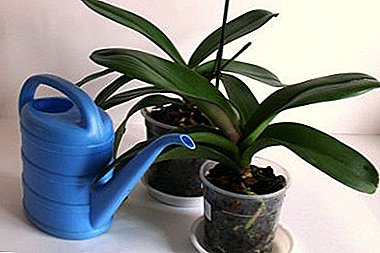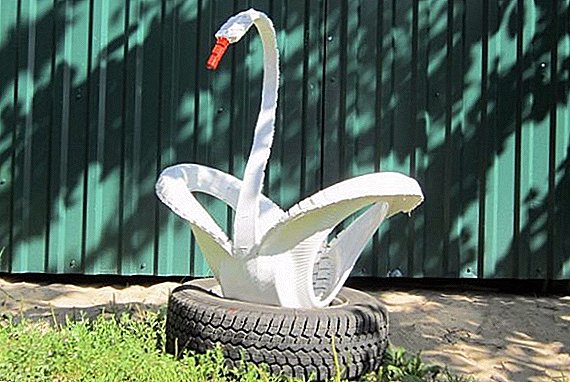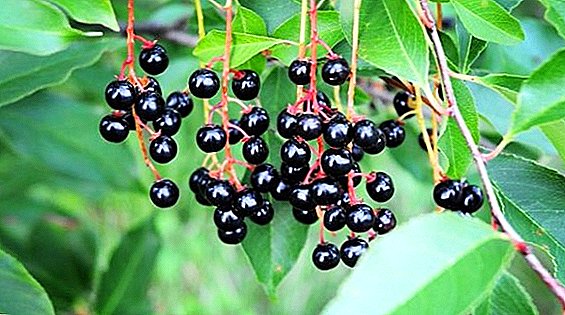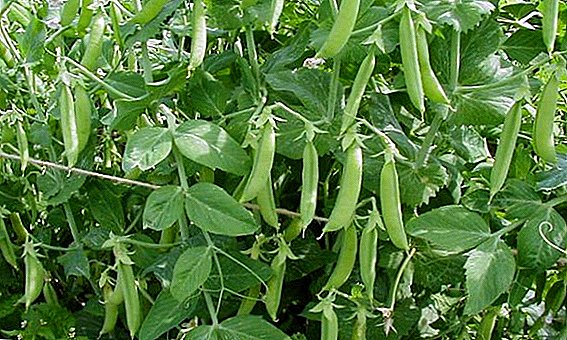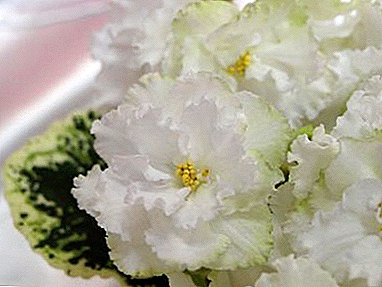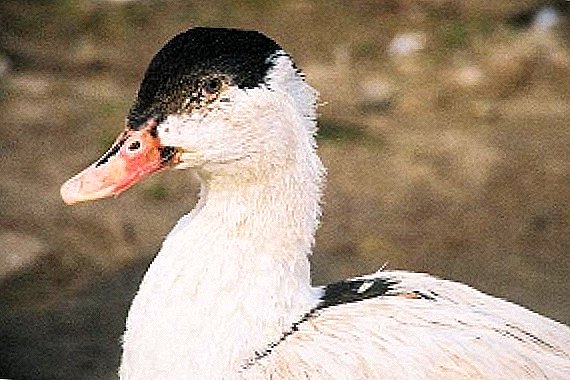
Many gardeners and those who have private plots, breeding animals at home.
In the presence of a sufficient forage base to engage in animal husbandry is not at all difficult, especially since the benefits of such an occupation are substantial.
You have not only actually free meat, but you know everything about its origin.
Naturally, the easiest way to deal with birds, because and feed them cheaply, they do not require special sheds for housing, and you can only grow them from spring to autumn, and next year you can buy new breed chicks.
Today we want to talk about the breed of ducks called Mulard, the removal of which can bring substantial income and benefits.
Mulard ducks: we grow for meat, but not for posterity

This breed of ducks not so long ago appeared in the bird market. These birds are attracted by the fact that they have a black spot on their heads.
Also, many people call them "mulatto" for this sign, since the rest of their body is absolutely white. Mulardy are hybrids, because they are not obtained in a natural way, but by crossing different types of ducks.
In this case, we are talking about crossing the nutmeg duck, which you probably heard a lot about, since they are very common with the usual domestic Peking duck.
To further interest you Mulard breed, do not forget to mention the "broiler" ducks of this breed.
In cultivation, they are absolutely universal: they can be bred at home for the needs of one family, and also used for industrial feeding of poultry and the further sale of its meat.
The only caveat - "broilers" are valued somewhat more expensive than ordinary meat ducks, although the result is higher.
It is worth noting that the birthplace of this hybrid is France, where professional breeders really tried their best, endowing the new breed with exclusively positive qualities, eliminating almost all the shortcomings of the original duck breeds.
Therefore, familiarity with the Mulard breed will begin from the characteristics of its breeding forms.
Features breeds of ducks used for breeding Mulardov

First of all it is important to note that the breeding breeds of the described ducks have a lot of differences.
In particular, if musk ducks are characterized by a calm nature and tidiness, for which many value them, then Peking ducks are quite the opposite - they are unusually noisy, their feathers are constantly dirty and not at all tidy. Although it is not the most important characteristic of the breed, it still often plays an important role.
We suggest that you familiarize yourself with the other characteristics of these breeds from the table below.
Meat quality and characteristics
Muskard Duck: The quality is very high, has excellent taste characteristics, has a large number of nutrients that are beneficial to humans.
Peking Duck: In general, the meat has good quality, but the variety is not recommended for meat cultivation. With abundant feeding, the breed forms not a muscle mass, but a fat mass, after which they lose their industrial significance.
Features weight gain
Muscovy duck: Initially, the breed has a low weight, it also gains it at insignificant rates.
Peking Duck: Gaining weight very quickly, is the champion in this regard.

Begin egg laying
Muscovy duck: Aged 8-9 months. Egg-laying lasts about 3-4 months, after which the bird begins to molt. At the beginning of a certain period of time, the cycle is restored back.
Peking Duck: At the age of 29-30 weeks, that is, at 7-7.5 months. In sexual maturation, this breed is ahead of many others. The productivity of one year of duck life is approximately 7 months.
Live weight
Muskard duck: Females weigh about 2.5 kilograms, and males can reach 5.
Peking Duck: Duck 3 kilograms, drake - 3.5. The weight of 8 monthly ducklings ranges from 1.8 to 2.2 kilograms.
As a result of the selection of the two described breeds, it was possible to mutually supplement all the shortcomings with the help of the most remarkable advantages. Thus, briefly describing the Mulard duck, it can be noted that they are calm, have good meat quality, gain weight well and are quite productive in laying.
What are the advantages of the breed or detailed acquaintance with the ducks Mulard

First of all, you should pay attention to the excellent immune system of ducks of this breed. Even with not the best conditions they are sick very rarely. In addition, the Mularda are distinguished by a very strong bush, their musculature is developed no worse (it’s not for nothing that the breed is considered to be meaty).
"Broilers" have even more advantages in this captivity, for which the conditions of detention are absolutely irrelevant, since they will be able to adapt to any.
The greatest advantage and dignity of the Moulard broilers is the ability to easily endure temperature drops and drops. In any case, these birds will consistently gain weight, regardless of feeding habits, especially since they don’t go through the latter at all.
The advantage of the breed is not only the good quality of the resulting meat, but also duck liver. It is believed that the liver of the described breed is best suited for the production of foie gras. Contributes to this, not only its softness and large size, but also nutritional value.
Among the others merits Mulard ducks should be called:
- The cleanliness that the breed inherited from musk ducks. Thus, even in adulthood, these ducks can be used for sale, their down and feathers can be used for industrial purposes.
- The calm character of the ducks, which again was inherited from musk ducks. This characteristic is very important in the domestic breeding of these birds, because they rarely hear loud quacking, and they will not rush around the yard (especially if they divert any body of water).
- Early maturity, that is, the onset of egg-laying in females. In this breed, it starts at 180-210 a day. The female lays a large number of eggs, but they are not fertilized.
- High quality meat. We have already mentioned that the musk breed of ducks used for breeding Moulards is characterized by a very good quality of meat, which the inherited breed also inherited.
However, it is precisely for the production of meat that females are predominantly raised, but males are raised for the production of liver and foie gras. After all, the weight of the liver of a single drake can be 500-550 grams.
- Expanse in breeding and cultivation. The essence of this point is what we have already mentioned a little above, namely, in the unpretentiousness of the described ducks to food, their adaptability to temperature conditions and a good immune system.
We must not forget about the high productivity of Mulard ducks, since they not only provide a large amount of meat, but also provide their owners with eggs and a healthy liver.
The disadvantages that will be faced when breeding and growing ducks Mulard

These ducks have a calm disposition, and give a lot of meat, and they have the best liver, and they will provide you with eggs, but there are also disadvantages to this breed.
The fact is that hybrid ducks moladr unable to bear offspring. Even those eggs that they produce are completely unsuitable for breeding ducklings, since they are unfertilized.
Thus, it is often necessary to constantly buy new ducklings in order to raise poultry for meat. But still it is not always necessary to do this, and often, because it is still possible to achieve a new offspring of the Mulardov.
It should also be noted that such a breed of ducks as Mulard does not exist in nature, since its breeding breeds live in very different ranges, and they can only be crossed artificially.
In particular, since breeders bred this breed from musk and Peking ducks, if you keep the male of the first breed at home and the female of the second (well, or vice versa, although there are some nuances here), then it is realistic to get the offspring of the breed you need.
Of course, such a home hybridization is not always able to give 100% results, because, after all, you have to deal with unpredictable genetics, but in most cases even this method gives very good and accurate results.
But even here there are some nuances: the musk breed drake is very difficult to force to fertilize a female from a breed other than its own. To make this happen, you need to be very cleverly cunning, putting it one in a whole herd of Peking females and separated from others and from your own breed. But even in this case, the percentage of fertilized will be about 70%.
At home, it is more efficient to have a peking duck, and musk females. Mating in this case will be more effective, but the offspring may inherit the ability to accumulate weight from the mother and will not please you with more meat.
Thus, the Moulards obtained at home will not necessarily differ in all the characteristics of their breed. However, if successful, you can sell the ducklings, who are very highly valued.
Other features of the breed and its distinctive characteristics
If you are determined to start growing Mulard ducks, you should also familiarize yourself with their external description.
In most cases, this hybrid breed is painted white and has a small black spot on the head.
However, the key word in the previous sentence is the very same phrase "hybrid form", which quite often gives quite different combinations of bird colors. Therefore, if you get black or brown ducklings at home breeding of Peking and musk ducks, do not be in a hurry to get upset, they can show very good results with further growth.
What is the productivity of duck Mulard? A bit about the most important parameters.

Naturally, the domestic cultivation of ducks primarily involves the use of their meat. In the case of the Mulardes, this is also natural because the breed is exactly the same as meat, because it is capable of accumulating a live mass well.
So, in adulthood, the weight of the drakes ranges from 6 to 7 kilograms, and females from 5.5 to 6.5 kilograms. A very big advantage is also the fact that even 7-10 weeks old youngsters very quickly gain weight even with not very abundant feeding, and their weight in such a malt age usually ranges from 1.3 to 1.5 kilograms.
The egg yields of these ducks are also quite high. One duck in one season can produce about 250-270 unfertilized eggs, which are quite well suited for cooking. Females start to bear fruit already on the 180-210 day of their life.
It is also interesting to read about meat and egg breeds of chickens.
We are engaged in breeding Miladr ducks: how to provide the birds with the most necessary?
Although this breed of ducks is not considered capricious, it is also important for her to provide good conditions for gaining weight. When only small ducks are born, it is important that hay or straw serve as a litter for them, but in no case should saw be used.
The reason for this lies in the fact that the sawdust is very intensely saturated with moisture and dries for a long time when compared to hay. And since moisture is the main source of life for ducks, sawdust will be wet all the time and may cause the death of part of the offspring.
In view of the latter, it is impossible to deprive this bird of its habitat, that is, habitual for it, that is, of water bodies.
Thus, if you are going to grow ducks, think in advance how to do it at least artificially. After all, even ducklings at the age of 30 days are important. constantly walking near the waterwhich is also a natural food source for these poultry.
Also, another important rule is that it is better to keep them separate from other birds, so they grow and feed better.
What and how often you need to feed the Mulardov: make up the optimal diet

If you did not buy small ducklings on the market, but decided to buy eggs of this breed, then you should also know how to feed them from the moment they hatch from the eggs.
First of all, they need to be drunk, using for this purpose a very weak solution of potassium permanganate (high concentration can harm the birds). Also, from the first days they need to be given boiled porridge mixed with boiled egg. At the same time, the consistency of porridge should be quite liquid, so that the ducklings receive moisture from their food.
It is also important to bear in mind that ducks of this breed begin to feed on their own only from the third day of life, while they cannot be immediately transferred to solid food. Only - after some time you can start add chopped greens to the mash.
And now, starting from the second week of their life, the diet can be diluted with boiled potatoes.
With further feeding of the ducks, we should not forget about mineral substances that will contribute not only to good growth, but also to the health of the birds. In particular, it may be:
- A piece of chalk;
- Seashells;
- Eggshell.
An important aspect of feeding ducklings is to provide them with water, which they are very fond of in their duck nature. In this regard, it is worth to be attentive to the fullness of the drinkers and constantly pour clean water into them.
And of course, that it is best to send them to the reservoirs, so that they themselves provide not only water, but also useful duckweed for them. If there is no reservoir in the vicinity, then the duckweed will still have to be thrown into the troughs.
Lighting when breeding ducklings: why and for how long?

Providing ducklings with lighting is very important, since this factor ensures their adaptation to external conditions. In particular, immediately after the birth of them need around the clock lighting.
When the little ducklings grow up a little, start eating more abundantly and move more freely, you can reduce the amount of light a little, including it only by 15-17 hours a day.
What temperature do birds need?
After the birth of the ducklings, they also need a lot of heat, because at low temperatures they will die. If they were removed using an incubator, then during sleep you need to maintain the temperature at 28 to 30 ° C, but at the usual time when they behave actively, not lower than 23 ° C.
After all, with the natural appearance of ducklings, their mother provides them with warmth, and under such artificial conditions, you must shift this responsible mission onto your shoulders.
At what age is a bird best for meat?
It is believed that Mulardov best let on meat at 2 or 3 months of age. If you provide them with good food, by this time they will reach quite good indicators of weight, and the meat will be very tender.
It is very important that in the interval between the indicated dates it is not recommended to kill the bird, which is connected with the processes of growth and puberty.



